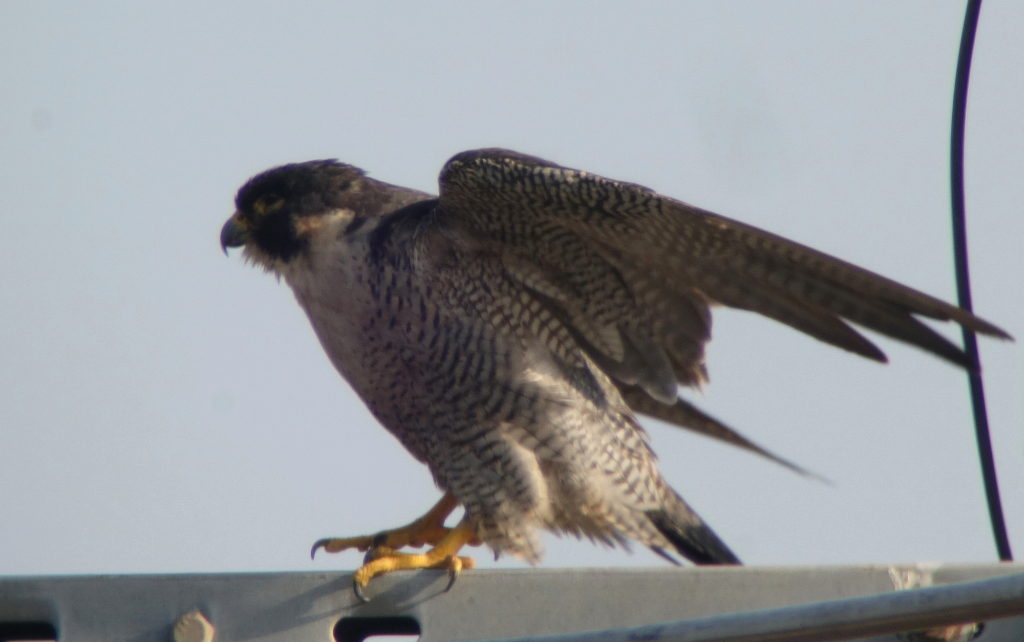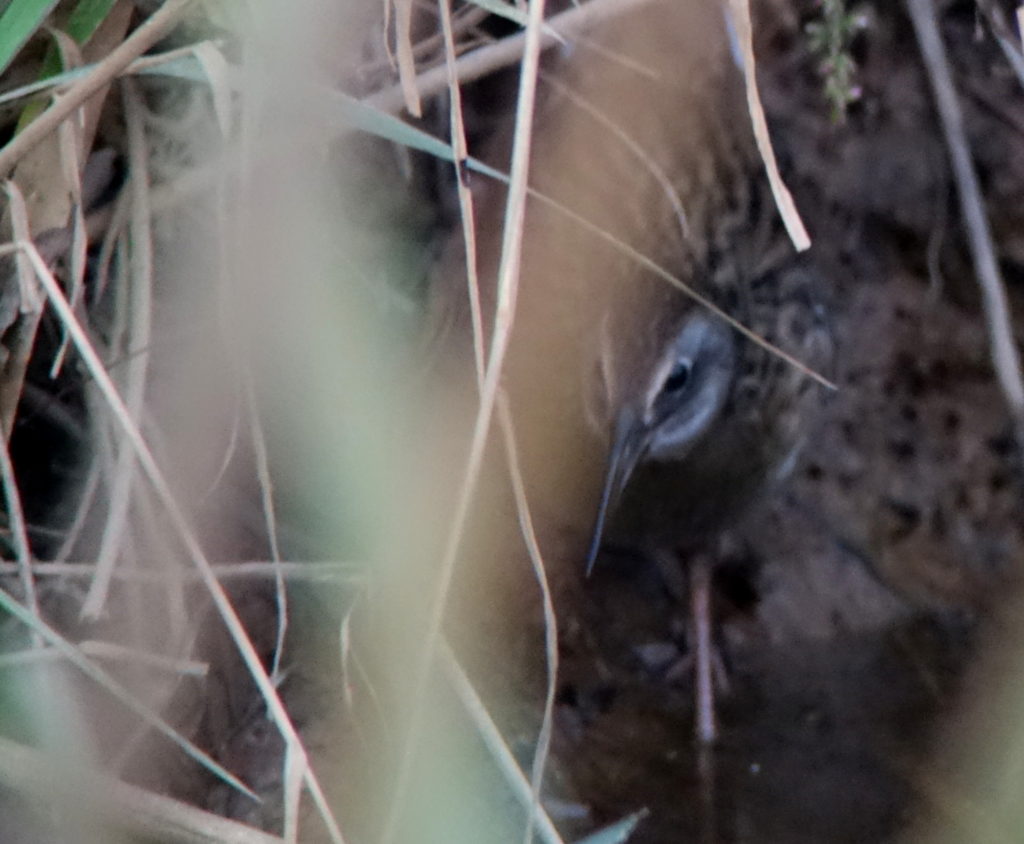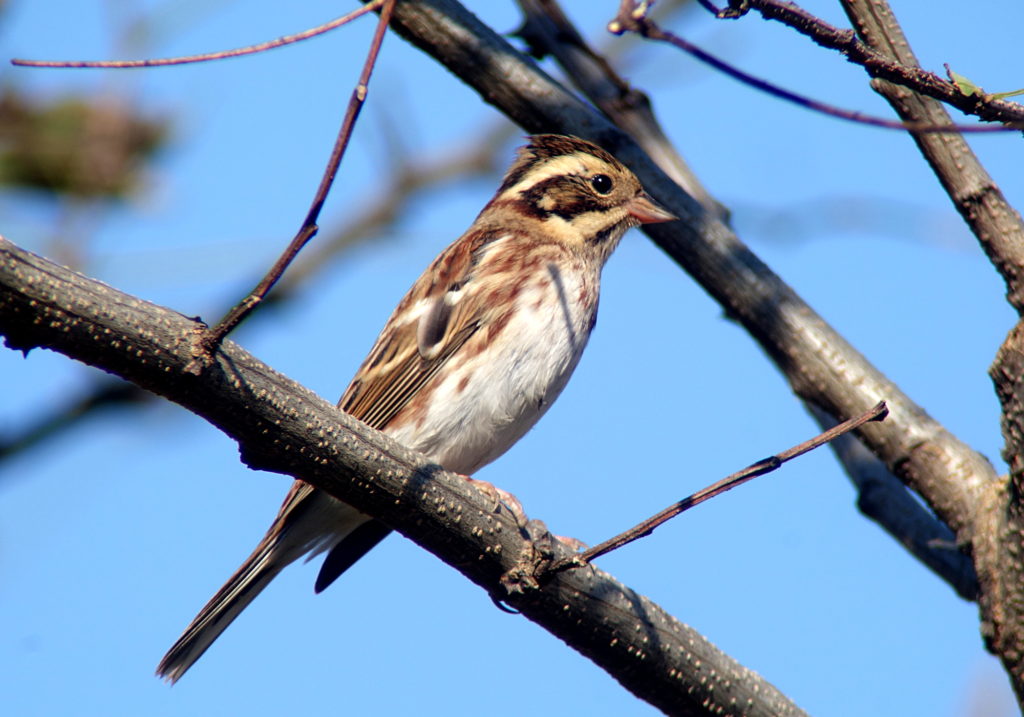Bird News from Nial Moores
On the 15th, light southerlies and still warm conditions (with a very humid high of 20C), with highlights in Jincheon a water rail sp seen only in flight at dawn, a personal high count in Korea of at least 30 Yellow-bellied Tit (a species first recorded here little more than a decade ago), single Hume’s Leaf Warbler and at least two Yellow-breasted Bunting. Most of the birds stayed deep in cover, including 8+ Tristram’s Bunting and most of the warblers that were logged, including almost all of the 23 Dusky and 36 Yellow-browed Warblers recorded in the small part of the island that was covered. The oddest and most frustrating was a song heard five or six times over a 20 minute period from a very birdy patch of habitat that sounded identical to Willow Warbler.
 Tristram’s Bunting Emberiza tristrami © Nial Moores
Tristram’s Bunting Emberiza tristrami © Nial Moores
On the 16th, light winds, rain from about 7AM through to midday and reduced visibility (<5km) resulted in a major arrival of birds with 76 species logged. In Jincheon (in the northeast), at least 2,900 Brambling and 500 Olive-backed Pipit were counted arriving / on the move in the first three hours of the day, along with good numbers of buntings (e.g. 500+ Black-faced, 30 Chestnut and ten Chestnut-eared Buntings).
In addition to small numbers of typical autumn migrants including Asian Brown and Taiga Flycatchers, the worst and best of the day were at Yeonhwa Ri, where large-scale habitat modification continues.

Taiga Flycatcher Ficedula albicilla © Nial Moores
Worst moment of the day was finding a dead Little Owl trapped in waste oil-tar: yet another terrible man-made hazard and another terrible wasted life (a separate patch nearby claimed a Brown Shrike and Olive-backed Pipit last year).
 Little Owl Athene noctua © Nial Moores
Little Owl Athene noctua © Nial Moores
Much more positively, as I counted birds along an especially birdy patch of stream, a group of buntings flew up and dropped back heavily into cover – in so doing flushing a similarly small, very dark round-winged bird with dangling legs and a short-looking bill. As the bird fluttered into cover, it showed extensive clear white on the secondaries of the spread wing: Swinhoe’s Rail! With perhaps still fewer than ten national records (?) this was only my third or fourth record in Korea – the most recent being one heard in Rason in the far northeast provinces in July. Waiting unsuccessfully for an hour for the bird to reappear, there was a moment of anticipation as some of the vegetation started to move. Not a rail, but a warbler emerged – a little long in the bill and tail, gingery-toned on the flanks and rump especially, with a dark brown brow: Manchurian Reed Warbler.
On the 17th, time spent surveying in Jincheon, Junghwadong and Yeonhwa Ri resulted in 76 species logged, with a total of eight Peregrine Falcon and still 115 Black-faced Bunting and 630 Olive-backed Pipit counted and highlights including an Eastern Water Rail, single Lanceolated Warblers in all three areas and the first Chinese Grosbeak of this survey period.
 Peregrine Falcon Falco peregrinus © Nial Moores
Peregrine Falcon Falco peregrinus © Nial Moores
 Eastern Water Rail (otherwise known as Brown-cheeked Rail) Rallus indicus © Nial Moores
Eastern Water Rail (otherwise known as Brown-cheeked Rail) Rallus indicus © Nial Moores
 Black-faced Bunting Emberiza spodocephala © Nial Moores
Black-faced Bunting Emberiza spodocephala © Nial Moores
On the 18th, in very bright and clear conditions with excellent visibility, there was strong evidence of departure and onward movement of raptors. Although c. 150 Olive-backed Pipit remained in the east, highlights included several tight balls of Brambling (containing between 30 and 120 birds) steadily gathering height as they moved towards the east, then the northeast, shifting direction with each gain of altitude, shining dark and light like shorebirds, until they eventually disappeared against the sky; and single juvenile White-tailed and perhaps second calendar-year Greater Spotted Eagles moving west.

 Two Olive-backed Pipits Anthus hodgsoni © Nial Moores
Two Olive-backed Pipits Anthus hodgsoni © Nial Moores
On the 19th in continuing bright weather, highlights in Jincheon included a grounded Eurasian Bittern, 15+ Yellow-bellied Tit (including several high-flying birds moving west), a vocal Hume’s Leaf Warbler, three or four Pine Bunting and an increase in number of several bunting species, with 20+ Chestnut-eared, 25 Meadow, 5+ Little, 25+ Rustic and 30+ Yellow-throated Buntings.
 Chestnut-eared Bunting Emberiza fucata © Nial Moores
Chestnut-eared Bunting Emberiza fucata © Nial Moores
 Little Bunting Emberiza pusilla © Nial Moores
Little Bunting Emberiza pusilla © Nial Moores
 Rustic Bunting Emberiza rustica © Nial Moores
Rustic Bunting Emberiza rustica © Nial Moores
 Meadow Bunting Emberiza cioides © Nial Moores
Meadow Bunting Emberiza cioides © Nial Moores
A four hour-long raptor count resulted in totals of 114 Eastern Buzzard (including one of the “odd” type that has been noted in several previous autumns), 12+ Northern Goshawk, 12 Eurasian and 4+ Japanese Sparrowhawks, two Black Kite, single Crested Honey Buzzard and Western Osprey.
 Exceptional-looking Eastern Buzzard Buteo japonicus / with unknown influence (?) © Nial Moores. Several similar-looking individuals have been seen in previous autumns, remarkable in looking more compact than most other B. japonicus, with a very striking tail pattern and with obvious pale bases to the primaries; and quite solid-looking dark on the underparts, though contrasting with a typical pale breast band as shown by Western Buzzard Buteo buteo.
Exceptional-looking Eastern Buzzard Buteo japonicus / with unknown influence (?) © Nial Moores. Several similar-looking individuals have been seen in previous autumns, remarkable in looking more compact than most other B. japonicus, with a very striking tail pattern and with obvious pale bases to the primaries; and quite solid-looking dark on the underparts, though contrasting with a typical pale breast band as shown by Western Buzzard Buteo buteo.
(All images taken with a handheld and failing compact sony camera through a truly superb Swarovski scope)
